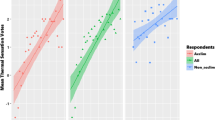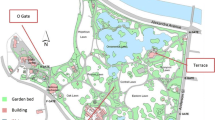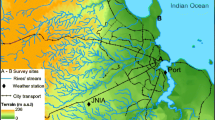Abstract
The largest market segment of global tourism is coastal tourism, which is strongly dependent on the destination's thermal climate. To date, outdoor bioclimatic comfort assessments have focused exclusively on local residents in open urban areas, making it unclear whether outdoor comfort is perceived differently in non-urban environments or by non-residents (i.e. tourists) with different weather expectations and activity patterns. This study provides needed insight into the perception of outdoor microclimatic conditions in a coastal environment while simultaneously identifying important psychological factors that differentiate tourists from everyday users of urban spaces. Concurrent micrometeorological measurements were taken on several Caribbean beaches in the islands of Barbados, Saint Lucia and Tobago, while a questionnaire survey was used to examine the thermal comfort of subjects (n = 472). Universal Thermal Climate Index (UTCI) conditions of 32 to 39 °C were recorded, which were perceived as being “slightly warm” or “warm” by respondents. Most beach users (48 to 77 %) would not change the thermal conditions, with some (4 to 15 %) preferring even warmer conditions. Even at UTCI of 39 °C, 62 % of respondents voted for no change to current thermal conditions, with an additional 10 % stating that they would like to feel even warmer. These results indicate that beach users’ thermal preferences are up to 18 °C warmer than the preferred thermal conditions identified in existing outdoor bioclimatic studies from urban park settings. This indicates that beach users hold fundamentally different comfort perceptions and preferences compared to people using urban spaces. Statistically significant differences (p ≤ .05) were also recorded for demographic groups (gender, age) and place of origin (climatic region).



Similar content being viewed by others
References
Amelung B, Viner D (2006) Mediterranean tourism: exploring the future with the tourism climate index. J Sustain Tour 14(4):349–366
Amelung B, Nicholls S, Viner D (2007) Implications of global climate change for tourism flows and seasonality. J Travel Res 45(2):85–296
Andrade H, Alcoforado M-J, Oliveira S (2011) Perceptions of temperature and wind by users of public outdoor spaces: relationships with weather parameters and personal characteristics. Int J Biometeorol 5:665–680
Bedford T, Warner CG (1934) The globe thermometer in studies of heating and ventilation. Journal of Instrument Hygiene 34:428–432
Berrittella M, Bigano A, Roson R, Tol RSJ (2006) A general equilibrium analysis of climate change impacts on tourism. Tour Manag 27:913–924
Besancenot J (1991) Clima y Turismo. Masson, Barcelona
Bigano A, Hamilton JM, Tol RSJ (2006) The impact of climate on holiday destination choice. Climate Change 76:389–406
Blazejczyk K, Epstein Y, Jendritzky G, Staiger H, Tinz B (2012) Comparison of UTCI to selected thermal indices. Int J Biometeorol 56:515–535
Brager GS, de Dear RJ (1998) Thermal adaptation in the built environment: a literature review. Energy Build 27(1):83–96
Bröde P, Krüger EL, Rossi FA, Fiala D (2012) Predicting urban outdoor thermal comfort by the Universal Thermal Climate Index UTCI—a case study in Southern Brazil. Int J Biometeorol 56:471–480
Butler R (2001) Seasonality in tourism: issues and implications. In: Baum T, Lundtorp S (eds) Seasonality in tourism. Pergamon, London
Cahskan O, Cicek I, Matzarakis A (2012) The climate and bioclimate of Bursa (Turkey) from the perspective of tourism. Theor Appl Climatol 107:417–425
Credoc (2009) Climat, meteorology et frequentation touristique, rapport final. Ministere de L’Ecologie, de l’Eergie, du Developpement durable et de la Mer, Paris
de Dear R, Brager GS (2001) The adaptive model of thermal comfort and energy conservation in the built environment. Int J Biometeorol 45:100–108
de Dear R, Fountain ME (1994) Field experiments on occupant comfort and office thermal environments in a hot-humid climate. ASHRAE Trans 100:457–474
de Freitas CR (1990) Recreation climate assessment. Int J Climatol 10:89–103
de Freitas CR (2003) Tourism climatology: evaluating environmental information for decision making and business planning in the recreation and tourism sector. Int J Biometeorol 48(1):45–54
de Freitas CR, Scott D, McBoyle G (2008) A second generation climate index for tourism (CIT): specification and verification. Int J Biometeorol 52:399–407
Eugenio-Martin JL, Campos-Soria JA (2010) Climate in the region of origin and destination choice in outbound tourism demand. Tour Manag 31:744–753
Gamble DW, Leonard LA (2005) Coastal climatology products for recreation and tourism end users in Southeastern North Carolina. NOAA Coastal services Centre, Charleston
Gomez-Martin MA (2005) Weather, climate and tourism. A geographical perspective. Ann Tour Res 32(3):571–591
Gomez-Martin MA (2006) Climate potential and tourist demand in Catalonia (Spain) during the summer season. Clim Res 32:75–87
Hall CM (2001) Trends in ocean and coastal tourism: the end of the last frontier? Ocean Coast Manag 44(9–10):601–618
Hamilton JM, Lau MA (2005) The role of climate information in tourist destination choice decision-making. In: Gössling S, Hall CM (eds) Tourism and global environmental change. Routledge, London, pp 229–250
Hamilton J, Maddison D, Tol RSJ (2005) Climate change and international tourism: a simulation study. Glob Environ Chang 15:253–266
Hein L, Metzger MJ, Moreno A (2009) Potential impacts of climate change on tourism; a case study for Spain. Curr Opin Environ Sustain 1(2):170–178
Hill A (2009) Holiday deal abroad vanish in rush to flee the rain. The Observer, Sunday 9 August
Honey M, Krantz D (2007) Global trends in coastal tourism. Center on Ecotourism and Sustainable Development: http://www.responsibletravel.org/resources/documents/reports/Global_Trends_in_Coastal_Tourism_by_CESD_Jan_08_LR.pdf Accessed 30 Sep 2013
Hübner A, Gössling S (2012) Tourists perceptions of extreme weather events in Martinique. J Destination Mark Manag 1:47–55
ISO (1998) ISO 7726: Thermal environments—Instruments and methods for measuring physical quantities: International Organization for Standardization 2nd edn. International Organization for Standardization (ISO), Geneva
Jendritzky G, de Dear R, Havenith G (2012) UTCI—why another thermal index? Int J Biometeorol 56:421–428
Jones A, Phillips M (2011) Disappearing destinations. Climate change and future challenges for coastal tourism. CAB International, Wallingford
Knez I, Thorsson S (2006) Influences of culture and environmental attitude on thermal emotional and perceptual evaluations of a public square. Int J Biometeorol 50:258–268
Knez I, Thorsson S (2008) Thermal, emotional and perceptual evaluations of a park: Cross-cultural and environmental attitude comparison. Build Environ 43(9):1483–1490
Knez I, Thorsson S, Eliasson I, Lindberg F (2009) Psychological mechanisms in outdoor place and weather assessment: towards a conceptual model. Int J Biometeorol 53:101–111
Kozak M (2002) Comparative analysis of tourist motivations by nationality and destinations. Tour Manag 23:221–232
Lin TP (2009) Thermal perception, adaptation and attendance in a public square in hot and humid regions. Build Environ 42:2017–2026
Lin TP, Matzarakis (2008) Tourism climate and thermal comfort in Sun Moon Lake, Taiwan. Int J Biometeorol 52:281–290
Lin TP, de Dear R, Hwang RL (2010) Effect of thermal adaptation on seasonal outdoor thermal comfort. Int J Climatol 31(2):302–312
Lise W, Tol RSJ (2002) Impact of climate on tourist demand. Climate Change 55(4):429–449
Lohmann M, Kaim E (1999) Weather and holiday preference—image, attitude and experience. Rev Tour 2:54–64
Maddison D (2001) In search of warmer climates? The impact of climate change on flows of British tourists. Climate Change 49(1–2):193–208
Martinez Ibarra E (2011) The use of webcam images to determine tourist–climate aptitude: favourable weather types for sun and beach tourism on the Alicante coast (Spain). Int J Biometeorol 55:373–385
Matzarakis A, Lin TP (2011) Tourism climate information based on human thermal perception in Taiwan and Eastern China. Tour Manag 32:492–500
Matzarakis A, Mayer H (1996) Another kind of environmental stress: thermal stress. WHO collaborating centre for air quality management and air pollution control. Newsletter 18:7–10
Matzarakis A, Mayer H, Iziomon MG (1999) Applications of a universal thermal index: physiological equivalent temperature. Int J Biometeorol 43:76–84
Matzarakis A, Rudel E, Zygmuntowski M, Koch E (2010) Bioclimatic maps for tourism purposes. Phys Chem Earth 35:57–62
Matzarakis A, Rammelberg J, Junk J (2013) Assessment of thermal bioclimate and tourism climate potential for central Europe—the example of Luxembourg. Theor Appl Climatol 114:193–202
Mayer H, Höppe P (1987) Thermal comfort of man in different urban environments. Theor Appl Climatol 38(1):43–49
Mieczkowski Z (1985) The tourism climate index: a method of evaluating world climates for tourism. Can Geogr 29:220–233
Moore WR (2010) The impact of climate change on Caribbean tourism demand. Curr Issues Tour 13(5):495–505
Moreno A (2010) Mediterranean tourism and climate (change): a survey-based study. Tour Plan Dev 7:253–265
Moreno A, Amelung B (2009) Climate change and tourist comfort on Europe’s beaches in summer: a reassessment. Coast Manag 37:550–568
Moreno A, Amelung B, Santamarta L (2009) Linking beach recreation to weather conditions: a case study in Zandvoort, Netherlands. Tour Mar Environ 5(2–3):111–119
Morgan R, Gatell E, Junyent R, Micallef A, Ozhan E, Williams A (2000) An improved user-based beach climate index. J Coast Conserv 6:41–50
Nicholls S, Amelung B (2008) Climate change and tourism in northwestern Europe: impacts and adaptation. Tour Anal 13:21–31
Nikolopoulou M, Baker N, Steemers K (2001) Thermal comfort in outdoor urban spaces: understanding the human parameter. Sol Energy 70(3):227–235
Nikolopoulou M, Lykoudis S (2006) Thermal comfort in outdoor urban spaces: analysis across different European countries. Build Environ 41:1455–1470
Nikolopoulou M, Steemers K (2003) Thermal comfort and psychological adaptation as a guide for designing urban spaces. Energy Build 35:95–101
Oliveira S, Andrade H (2007) An initial assessment of the bioclimatic comfort in an outdoor public space in Lisbon. Int J Biometeorol 52:69–84
Paciuck M (1990) The role of personal control of the environment in thermal comfort and satisfaction at the workplace. In: Selby R, Anthony K, Choi J, Orland B (eds) Coming of age. Environment Design Research Association, Oklahoma
Parsons KC (1993) Human thermal environments. Taylor & Francis, London
Perch-Nielsen S, Amelung B, Knutt R (2010) Future climate resources for tourism in Europe based on the daily Tourism Climate Index. Climate Change 103(3/4):363–381
Perry A (1993) Climate and weather information for the package holiday-maker. Weather 48:410
Rutty M, Andrey J (2014) Weather forecast use for winter recreation. Weather, Climate, Society 1-13. doi:10.1175/WCAS-D-13-00052.1
Rutty M, Scott D (2010) Will the Mediterranean become “too hot” for tourism?: a reassessment. Tour Plan Dev 7:267–281
Rutty M, Scott D (2013) Differential climate preferences of international beach tourists. Clim Res 57:259–269
Scott D, Hall CM, Gössling S (2012) Tourism and climate change: Impacts, adaptation and mitigation. Routledge, London
Scott D, McBoyle G (2001) Using a ‘tourism climate index’ to examine the implications of climate change for climate as a natural resource for tourism. In: Matzarakis A, de Frietas C (eds) Proceedings of the first international workshop on climate, tourism and recreation, 5–10 October. International Society of Biometeorology, Commission on Climate, Tourism and Recreation, Halkidi, pp 69–98
Scott D, McBoyle G, Schwartzentruber M (2004) Climate change and the distribution of climatic resources for tourism in North America. Clim Res 27:105–117
Scott D, Gössling S, de Freitas C (2008) Climate preferences for tourism: evidence from Canada, New Zealand and Sweden. Clim Res 38:61–73
Spagnolo J, de Dear RJ (2003) A field study of thermal comfort in outdoor and semi-outdoor environments in subtropical Sydney Australia. Build Environ 38(5):721–738
Thorsson S, Lindberg F, Eliasson I, Holmer B (2007) Different methods for estimating the mean radiant temperature in an outdoor urban setting. Int J Climatol 27(14):1983–1993
Thorsson S, Lindqvist M, Lindqvist S (2004) Thermal bioclimatic conditions and patterns of behaviour in an urban park in Göteborg, Sweden. Int J Biometeorol 48:149–156
United Nations Environment Program (UNEP) Sustainable Coastal Tourism. An integrated planning and management approach. UNEP: http://www.unep.fr/shared/publications/pdf/DTIx1091xPA-SustainableCoastalTourism-Planning.pdf Accessed 30 Sep 2013
United Nations World Tourism Organization (UNWTO) UNWTO tourism highlights, 2013 Edition. UNWTO: http://dtxtq4w60xqpw.cloudfront.net/sites/all/files/pdf/unwto_highlights13_en_lr.pdf. Accessed 30 Sep 2013
Wirth K (2010) Auswirkungen des Klimawandels auf den Tourismus im Mittelmeerraum Prognosen ahand einer Umfrage in Munchen. Dissertation, Ludwig Maximilian Universitat Munchen
World Travel and Tourism Council (WTTC) (2011) Travel & tourism economic impact 2011 Caribbean. http://www.tourismiskey.com/downloads/2011/WTTC_Tourism2011.pdf Accessed 30 Sep 2013
Acknowledgments
Financial support from the Canada Research Chairs program, Social Sciences and Humanities Research Council of Canada (SSHRC) and the International Development Research Council (IDRC) is gratefully acknowledged.
Author information
Authors and Affiliations
Corresponding author
Rights and permissions
About this article
Cite this article
Rutty, M., Scott, D. Bioclimatic comfort and the thermal perceptions and preferences of beach tourists. Int J Biometeorol 59, 37–45 (2015). https://doi.org/10.1007/s00484-014-0820-x
Received:
Revised:
Accepted:
Published:
Issue Date:
DOI: https://doi.org/10.1007/s00484-014-0820-x




